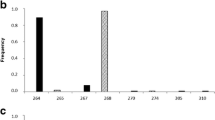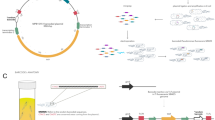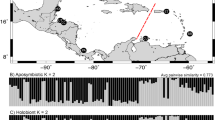Abstract
Asexual reproduction often predominates in populations of species experiencing range expansion. Locally selected genotypes can lead to the establishment of clonal populations that accumulate genetic diversity through time. Sexual reproduction has never been observed in extensive field and culture studies of the red alga Porphyra umbilicalis from Maine, USA, even though sexual reproduction predominates in this species in the eastern Atlantic (Europe). This suggests that Maine populations are indeed asexual and might consist of one or only a few genetic clones; we have tested this using AFLPs. Individuals were sampled at two sites in Maine (Cobscook Bay [n = 25], Schoodic Point [n = 26]) and compared to sexual individuals from England (Sidmouth [n = 17]). The AFLP analysis determined that individuals at two sites in Maine containing putative asexuals were not strictly clonal; however, two multilocus lineages were sampled more than once. Two genetic clones, one at each Maine site, were comprised of 6 individuals each; the 39 additional Maine individuals had distinctive AFLP genotypes. However, when the individuals from Maine were compared with a known sexual population from Sidmouth, England, much greater genetic diversity was found within the sexual population in England. Finally, we examine how preparation of field-collected material for AFLP investigations can affect the inclusion of non-target DNA and demonstrate an in silico approach for removing some cryptic contaminants from analysis.




Similar content being viewed by others
References
Adey W, Hayek L (2011) Elucidating marine biogeography with macrophytes: quantitative analysis of the North Atlantic supports the thermogeographic model and demonstrates a distinct subarctic region in the northwestern Atlantic. Northeast Nat 18:1–128
Arens P, Coops H, Jansen J, Vosman B (1998) Molecular genetic analysis of black poplar (Populus nigra L.) along Dutch rivers. Mol Ecol 7:11–18
Bell G, Gonzalez A (2011) Adaptation and evolutionary rescue in metapopulations experiencing environmental deterioration. Science 332:1327–1330
Birky CW (2010) Positively negative evidence for asexuality. J Hered 101:S42–S45
Blouin N, Xiugeng F, Peng J, Yarish C, Brawley SH (2007) Seeding nets with neutral spores of the red alga Porphyra umbilicalis (L.) Kutzing for use in integrated multi-trophic aquaculture (IMTA). Aquaculture 270:77–91
Bonin A, Bellemain E, Eidesen PB, Pompanon F, Brochmann C, Taberlet P (2004) How to track and assess genotyping errors in population genetics studies. Mol Ecol 13:3261–3273
Brawley SH, Coyer JA, Blakeslee AMH, Hoarau G, Johnson LE, Byers JE, Stam WT, Olsen JL (2009) Historical invasions of the intertidal zone of Atlantic North America associated with distinctive patterns of trade and emigration. P Natl Acad Sci USA 106:8239–8244
Brodie J, Irvine LM (2003) Seaweeds of the British Isles. Vol. 1. Part 3B. Bangiophycidae. British Museum of Natural History, London
Brodie J, Irvine L, Neefus CD, Russell S (2008) Ulva umbilicalis L. and Porphyra umbilicalis Kutz. (Rhodophyta, Bangiaceae): a molecular and morphological redescription of the species, with a typification update. Taxon 57:1328–1331
Cayrou C, Raoult D, Drancourt M (2010) Broad-spectrum antibiotic resistance of planctomycetes organisms determined by Etest. J Antimicrob Chemoth 65:2119–2122
Coyer JA, Hoarau G, Costa JF, Hogerdijk B, Serrao EA, Billard E, Valero M, Pearson GA, Olsen JL (2011a) Evolution and diversification within the intertidal brown macroalgae Fucus spiralis/F. vesiculosus species complex in the North Atlantic. Mol Phylogenet Evol 58:283–296
Coyer JA, Hoarau G, Van Schaik J, Luijckx P, Olsen JL (2011b) Trans-Pacific and trans-Arctic pathways of the intertidal macroalga Fucus distichus L. reveal multiple glacial refugia and colonizations from the North Pacific to the North Atlantic. J Biogeogr 38:756–771
Cunningham CW (2008) How to use genetic data to distinguish between natural and human-mediated introduction of Littorina littorea to North America. Biol Invasions 10:1–6
Dhar R, Sagesser R, Weikert C, Yuan J, Wagner A (2011) Adaptation of Saccharomyces cerevisiae to saline stress through laboratory evolution. J Evol Biol 24:1135–1153
Dixon P (1965) Perennation, vegetative propagation and red algal life histories, with special reference to Asparagopsis and other Rhodophyta. Bot Goth 3:67–74
Donini P, Elias ML, Bougourd SM, Koebner RMD (1997) AFLP fingerprinting reveals pattern differences between template DNA extracted from different plant organs. Genome 40:521–526
Douhovnikoff V, Dodd RS (2003) Intra-clonal variation and a similarity threshold for identification of clones: application to Salix exigua using AFLP molecular markers. Theor Appl Genet 106:1307–1315
Feschotte C, Pritham EJ (2007) DNA transposons and the evolution of eukaryotic genomes. Annu Rev Genet 41:331–368
Foll M, Fischer MC, Heckel G, Excoffier L (2010) Estimating population structure from AFLP amplification intensity. Mol Ecol 19:4638–4647
Fuerst JA, Gwilliam HG, Lindsay M, Lichanska A, Belcher C, Vickers JE, Hugenholtz P (1997) Isolation and molecular identification of planctomycete bacteria from postlarvae of the giant tiger prawn, Penaeus monodon. Appl Environ Microb 63:254–262
Gaggiotti OE (2010) Bayesian statistical treatment of the fluorescence of AFLP bands leads to accurate genetic structure inference. Mol Ecol 19:4586–4588
Gomez A, Carvalho GR (2000) Sex, parthenogenesis and genetic structure of rotifers: microsatellite analysis of contemporary and resting egg bank populations. Mol Ecol 9:203–214
Govindarajan AF, Halanych KM, Cunningham CW (2005) Mitochondrial evolution and phylogeography in the hydrozoan Obelia geniculata (Cnidaria). Mar Biol 146:213–222
Guillard R (2005) Purification methods for microalgae. In: Andersen RA (ed) Phycological methods: algal culturing techniques. Elsevier Academic Press, Burlington, pp 117–132
Hallatschek O, Nelson DR (2010) Life at the front of an expanding population. Evolution 64:193–206
Hallatschek O, Hersen P, Ramanathan S, Nelson DR (2007) Genetic drift at expanding frontiers promotes gene segregation. P Natl Acad Sci USA 104:19926–19930
Hampe A, Petit RJ (2005) Conserving biodiversity under climate change: the rear edge matters. Ecol Lett 8:461–467
Iitsuka O, Nakamura K, Ozak IA, Okamoto N, Saga N (2002) Genetic information of three pure lines of Porphyra yezoensis (Bangiales, Rhodophyta) obtained by AFLP analysis. Fish Sci 68:1113–1117
Lasso E (2008) The importance of setting the right genetic distance threshold for identification of clones using amplified fragment length polymorphism: a case study with five species in the tropical plant genus Piper. Mol Ecol Resour 8:74–82
Maggs CA, Castilho R, Foltz D, Henzler C, Jolly MT, Kelly J, Olsen J, Perez KE, Stam W, Vainola R, Viard F, Wares J (2008) Evaluating signatures of glacial refugia for North Atlantic benthic marine taxa. Ecology 89:S108–S122
Mandegar MA, Otto SP (2007) Mitotic recombination counteracts the benefits of genetic segregation. P R Soc B 274:1301–1307
Meirmans PG, Van Tienderen PH (2004) GENOTYPE and GENODIVE: two programs for the analysis of genetic diversity of asexual organisms. Mol Ecol Notes 4:792–794
Meudt HM, Clarke AC (2007) Almost forgotten or latest practice? AFLP applications, analyses and advances. Trends Plant Sci 12:106–117
Muhlin JF, Brawley SH (2009) Recent versus relic: discerning the genetic signature of Fucus vesiculosus (Heterokontophyta; Phaeophyceae) in the Northwestern Atlantic. J Phycol 45:828–837
Niwa K, Kikuchi N, Iwabuchi M, Aruga Y (2004) Morphological and AFLP variation of Porphyra yezoensis Uedo form narawaensis Miura (Bangiales, Rhodophyta). Phycol Res 52:180–190
Olsen JL, Zechman FW, Hoarau G, Coyer JA, Stam WT, Valero M, Aberg P (2010) The phylogeographic architecture of the fucoid seaweed Ascophyllum nodosum: an intertidal ‘marine tree’ and survivor of more than one glacial-interglacial cycle. J Biogeogr 37:842–856
Otto SP (2009) The evolutionary enigma of sex. Am Nat 174:S1–S14
Pearson EA, Murray SN (1997) Patterns of reproduction, genetic diversity, and genetic differentiation in California populations of the geniculate coralline alga Lithothrix aspergillum (Rhodophyta). J Phycol 33:753–763
Provan J, Bennett KD (2008) Phylogeographic insights into cryptic glacial refugia. Trends Ecol Evol 23:564–571
Provan J, Maggs CA (2012) Unique genetic variation at a species’ rear edge is under threat from global climate change. P Roy Soc B-Biol Sci 279:39–47
Schlotterer C (2004) The evolution of molecular markers: just a matter of fashion? Nat Rev Genet 5:63–69
Sears J (2002) NEAS keys to the marine algae of the Northwestern Coast of North America. Northeastern Algal Society, Fall River
Slotkin RK, Martienssen R (2007) Transposable elements and the epigenetic regulation of the genome. Nat Rev Genet 8:272–285
Song YX, Scheu S, Drossel B (2011) Geographic parthenogenesis in a consumer-resource model for sexual reproduction. J Theor Biol 273:55–62
Sosa PA, Lindstrom SC (1999) Isozymes in macroalgae (seaweeds): genetic differentiation, genetic variability and applications in systematics. Eur J Phycol 34:427–442
Sutherland JE, Lindstrom SC, Nelson WA, Brodie J, Lynch MDJ, Hwang MS, Choi HG, Miyata M, Kikuchi N, Oliveira MC, Farr T, Neefus C, Mols-Mortensen A, Milstein D, Muller KM (2011) A New Look at an Ancient Order: generic Revision of the Bangiales (Rhodophyta). J Phycol 47:1131–1151
Teasdale BW, Klein AS (2010) Genetic variation and biogeographical boundaries within the red alga Porphyra umbilicalis (Bangiales, Rhodophyta). Bot Mar 53:417–431
Teasdale BW, West A, Klein AS, Mathieson AC (2009) Distribution and evolution of variable group-I introns in the small ribosomal subunit of North Atlantic Porphyra (Bangiales, Rhodophyta). Eur J Phycol 44:171–182
Van der Hulst RGM, Mes THM, Falque M, Stam P, Den Nijs JCM, Bachmann K (2003) Genetic structure of a population sample of apomictic dandelions. Heredity 90:326–335
Vos P, Hogers R, Bleeker M, Reijans M, Vandelee T, Hornes M, Frijters A, Pot J, Peleman J, Kuiper M, Zabeau M (1995) AFLP - a new technique for DNA-fingerprinting. Nucleic Acids Res 23:4407–4414
Welch DBM, Meselson MS (2001) Rates of nucleotide substitution in sexual and anciently asexual rotifers. P Natl Acad Sci USA 98:6720–6724
West JA, McBride DL (1999) Long-term and diurnal carpospore discharge patterns in the Ceramiaceae, Rhodomelaceae, and Delessariaceae (Rhodophyta). Hydrobiol 288(289):101–103
Winfield MO, Arnold GM, Cooper F, Le Ray M, White J, Karp A, Edwards KJ (1998) A study of genetic diversity in Populus nigra subsp. Betulifolia in the Upper Severn area of the UK using AFLP markers. Mol Ecol 7:3–10
Yang R, Liu B, Luo Q, Wang Y, Bao J (2003) Genetic variation of Porphyra yezoensis by using AFLP. Acta Oceanol Sin/Haiyang Xuebao 22:453–457
Young AM, Torres C, Mack JE, Cunningham CW (2002) Morphological and genetic evidence for vicariance and refugium in Atlantic and Gulf of Mexico populations of the hermit crab Pagurus longicarpus. Mar Biol 140:1059–1066
Acknowledgments
We thank Dr. Juliet Brodie (Natural History Museum, London) for her help with the Sidmouth collections. We also gratefully acknowledge support of this work by NOAA # NA06OAR4170108 to SHB, a Community Sequencing Award for P. umbilicalis from the Joint Genome Institute (U. S. DoE) Contract No. DE-AC02-05CH11231 (PIs: SHB, E. Gantt, A. Grossman, J. Stiller), NSF Research Collaboration Network grant 0741907 (PIs: SHB, EG, AG, JS).
Author information
Authors and Affiliations
Corresponding author
Additional information
Communicated by S. Uthicke.
Rights and permissions
About this article
Cite this article
Blouin, N.A., Brawley, S.H. An AFLP-based test of clonality in widespread, putatively asexual populations of Porphyra umbilicalis (Rhodophyta) in the Northwest Atlantic with an in silico analysis for bacterial contamination. Mar Biol 159, 2723–2729 (2012). https://doi.org/10.1007/s00227-012-2029-z
Received:
Accepted:
Published:
Issue Date:
DOI: https://doi.org/10.1007/s00227-012-2029-z




